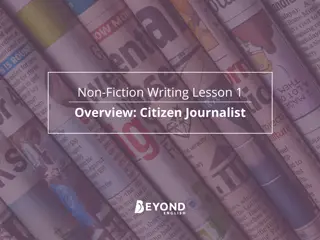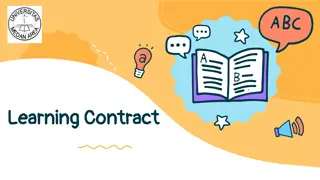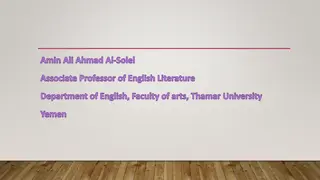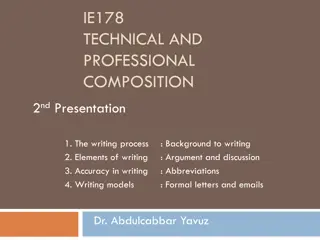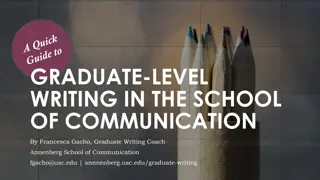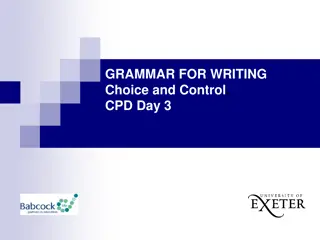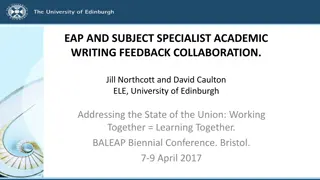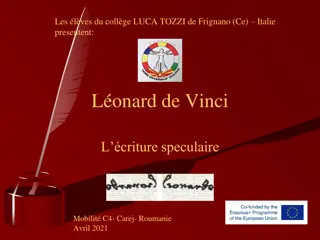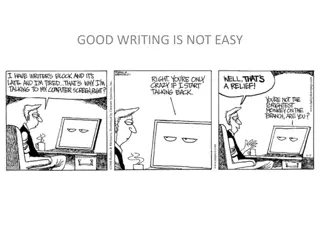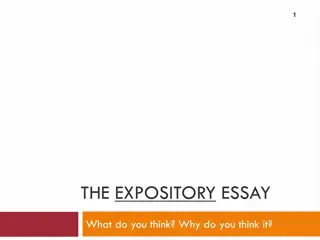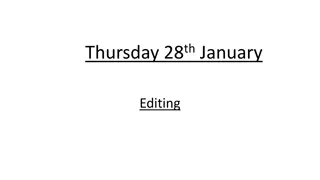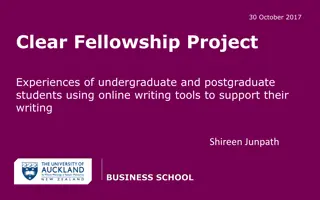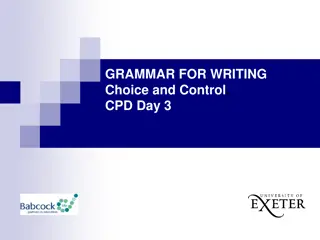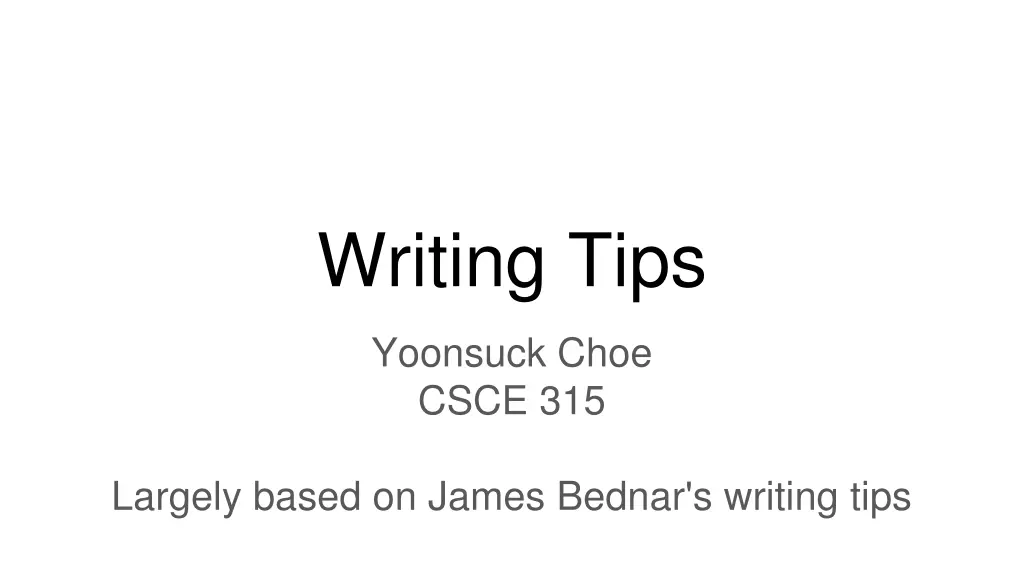
Effective Writing Tips for Academic and Technical Success
Discover valuable tips for academic and technical writing, emphasizing clarity, professionalism, and organization. Learn how to make your thesis clear, stay on topic, use transitions effectively, and more to enhance your writing skills.
Download Presentation

Please find below an Image/Link to download the presentation.
The content on the website is provided AS IS for your information and personal use only. It may not be sold, licensed, or shared on other websites without obtaining consent from the author. If you encounter any issues during the download, it is possible that the publisher has removed the file from their server.
You are allowed to download the files provided on this website for personal or commercial use, subject to the condition that they are used lawfully. All files are the property of their respective owners.
The content on the website is provided AS IS for your information and personal use only. It may not be sold, licensed, or shared on other websites without obtaining consent from the author.
E N D
Presentation Transcript
Writing Tips Yoonsuck Choe CSCE 315 Largely based on James Bednar's writing tips
Goal of academic/technical writing Convey your ideas clearly and professionally. Grammar Style Organization
General guidelines Formal writing is not just dictated conversation Make your thesis obvious throughout When in doubt, use the following recipe: Introduce/ Expand/justify/Conclude Stay on topic Transitions Write what you mean, mean what you write Avoid redundancy Be professional and diplomatic Avoid imperative voice
Formal writing is not just dictated conversation Do not just write down as you would speak. No way for readers to ask questions when unclear. Document must be self-contained. Must construct Meaningful sentences, paragraphs, and arguments relevant to the main thesis Hard to write, but must be easy to read and follow.
Make your thesis obvious throughout Article must have one main topic (the "thesis") Clearly stated in the introduction and conclusion Usually the last sentence in the introduction Introductory paragraph (in short essay) Introduction section (in longer articles) When in doubt, reiterate in the text.
When in doubt, use the following recipe Use the following structure at all levels: Book, Chapter, Section, Subsection, Paragraph. 1. Make the topic clear 2. Expand upon it (explain, argue, cover relevant materials, ) 3. Sum up, tying everything back to the main thesis.
Stay on Topic Focus on the main thesis Avoid the temptation to talk about all the other related stuff that come to your mind. If you have to bring up something related, be prepared to say something important about it. Do acknowledge potential weaknesses in your argument, thesis, etc.
Transitions Each sentence should follow smoothly from the preceding sentence. Each paragraph should follow smoothly from the preceding paragraph, etc. Keeping things ordered in a "linear" fashion is important. Good transitions greatly helps reading in a linear fashion, without the need to flip back and forth. When switching topic, insert words like "However, ", "As a result, ", etc. If doing this too often, the flow is not good.
Write what you mean, mean what you write Avoid phrases/idioms that are too colloquial and thus imprecise: .. going the extra mile .. .. at the end of the day .. .. hard facts .. .. crystal clear .. .. sticking to .. .. (something) really (being the case).. If there were no actual miles involved, do not write of extra ones. If there was no actual crystal, do not write about its clarity.
Avoid redundancy Usually occurs when a minimum length is required of a document. Writing assignments, etc. Re-read sentences and paragraphs for any redundancy. Browser over the whole document for large blocks of redundant information.
Be professional and diplomatic When talking about someone else's work, write as if your subject may read your document. Avoid pejorative, insulting, or offensive terms: ... attempt to a waste of time so called inferior performance Better expressions has some limitations . have not fully investigated
Avoid imperative voice No one wants to be ordered to so something. Imperative voice may sound rude, in technical writing: "Recall that, " Some uses may be unavoidable and less objectionable: as has been demonstrated (also see XXXX 1999 for related results).
RECAP: Common Errors in CSCE 315 essays Redundancy Same thing repeated multiple times throughout the text Simple enumeration Common grammar errors Number agreement : verb and noun ; Punctuation. ; Tense Too colloquial Too choppy Transition within paragraph and across paragraphs not good Hard to maintain single line of thought while reading A string of single-sentence paragraphs.
Document organization Overall structure: Introduction Expand/justify Conclude Each paragraph is one relevant sub-topic Use complete sentences, with proper subject and verb. Use appropriate punctuation between sentences. Don't over use ":" or ";". Section titles: be explicit and brief. Introduction and conclusion must contain the most important information. Say it, not just promise to say it. If you say "In this paper, I will ", then do it. Subsections: Do not go straight to 1.1 after 1 without proper introductory text. Figure captions: provide enough context for the reader to understand.
Word-level issues Avoid ambiguous references: this, these, those, it, they, etc. Make clear what the words refer to. If not possible, write out what the word refers to. Watch out for homonyms. Its/it's, affect/effect, their/there/they're, complement/compliment, principle/principal In other words (o) / In another words (x) Research (o) / researches (x) Avoid "comprise": X comprises Y = X is composed of Y = X is comprised of Y "But" and "However" are not interchangeable (dependent on punctuation). Avoid contractions: haven't, can't, won't,
Extra: Academic Writing Guidelines Distinct styles exist: e.g., APA publication manual. https://apastyle.apa.org/products/publication-manual-7th-edition Pay attention to the appearance of your document "Authors" not "writers" Use last names to refer to other authors. Avoid unnecessary footnotes. Avoid direct quotes. Discussion existing work: findings, limitations, benefits. Discussion/future work: write what the audience may have expected to see. Bibliographies, citations : details may vary.
Common mistakes Articles Number agreement The data represents XXXX. (x) ; The data represent XXXX. (o) The comparison between X and Y are (x): The comparison between X and Y is (o) Anaphora We did X and the results were good. Later we did Y and found some issues. This can lead to some interesting directions. (x) ; . Comparing the results from X and Y can lead to (o) Here is a book. I read a book. (x); Here is a book. I read the book (o) This is an usual configuration (x); This is a usual configuration (o)
Common mistakes (cont'd) Parallel construction In experiment 1 we did X, while Y was done in experiment 2. (x) ; In experiment 1 we did X, while in experiment 3, we did Y. Parentheses (Figure 1) shows the main concept. (x) ; Figure 1 shows the main concept. (o) In this paper, we review XYZ (XYZ means ABC.) (x) ; In this paper, we review XYZ. (XYZ means ABC.) (o); In this paper, we review XYZ (XYZ means ABC). (o) Etc. vs. et al. : stuff vs. people Ambiguity due to long separation of noun and verb: The effect of normalized integration of the third order polynomical was measured. (x) ; We measured the effect of normalized integration of the third order polynomial. (o) Who did what? Experiments were conducted to test XYZ. (x) ; We conducted experiments to test XYZ. (o) ; Darwin conducted experiments to test XYZ (o)
Common mistakes Tense Everything you did in the past: past tense Everything other people did in the past: past tense Referring to figures and tables in current document: present tense In XXXX (1999), the authors test (x) ; In XXXX (1999), the authors tested (o) In this assignment, we develop an algorithm for (x); In this assignment, we developed an algorithm for (o) Figure X showed (x); Figure X shows (o) Oxford comma I love my parents, Lady Gaga and Humpty Dumpty. (x) ; I love my parents, Lady Gaga, and Humpty Dumpty. (o). (Your parents are not Lady Gaga and Humpty Dumpty.) Long sentences: break them. In this experiment we will do X and Y, and use method Z to analyze the results. (x); In this experiment, we will do X and Y. Based on the results, using method Z, we will (o)

